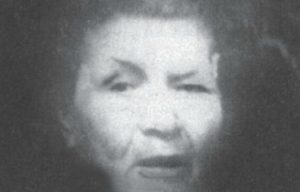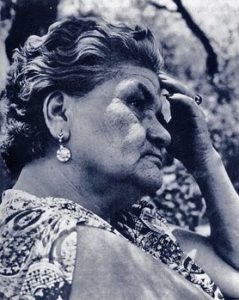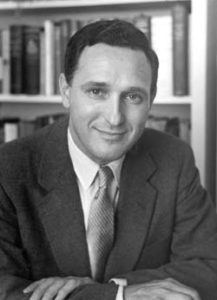Podcast: Play in new window | Download
Subscribe: Apple Podcasts | RSS
 In the Colonia Roma Norte neighborhood in Mexico City, across the street from the wooded and shady Plaza Rio de Janeiro stands a somewhat spooky-looking red brick building built in 1908. While the sign in the front of the building says “Edificio Rio de Janeiro,” the locals call this place something else: La Casa de las Brujas, or in English, “The House of Witches.” It is so named not just because of its spooky appearance. Visitors to the building and passersby have reported strange phenomena in and around the building. Apparitions of various forms have been sighted there and a strange energy field enveloping the building has been reported throughout the years, especially since the late 1970s. It is perhaps not just a coincidence that for many years the beautiful building in this somewhat upscale Mexico City neighborhood was home to one of Mexico’s most famous psychics and mystical healers, a woman known to all as Pachita. Pachita died there on April 29, 1979. To this day some claim to see her stout figure standing in one of the windows looking across the wooded plaza with a stern expression on her face.
In the Colonia Roma Norte neighborhood in Mexico City, across the street from the wooded and shady Plaza Rio de Janeiro stands a somewhat spooky-looking red brick building built in 1908. While the sign in the front of the building says “Edificio Rio de Janeiro,” the locals call this place something else: La Casa de las Brujas, or in English, “The House of Witches.” It is so named not just because of its spooky appearance. Visitors to the building and passersby have reported strange phenomena in and around the building. Apparitions of various forms have been sighted there and a strange energy field enveloping the building has been reported throughout the years, especially since the late 1970s. It is perhaps not just a coincidence that for many years the beautiful building in this somewhat upscale Mexico City neighborhood was home to one of Mexico’s most famous psychics and mystical healers, a woman known to all as Pachita. Pachita died there on April 29, 1979. To this day some claim to see her stout figure standing in one of the windows looking across the wooded plaza with a stern expression on her face.
 Pachita was born Bárbara Guerrero in the town of Parral in the Mexican state of Chihuahua in about the year 1900. As a little girl she began to hear voices and by the age of ten she was already demonstrating the ability to heal people. As a girl, she would slip into trances and claim that her body was being taken over by an entity she called, “El Hermanito,” or in English, “The Little Brother.” She would later identify El Hermanito as Cuauhtémoc, the last emperor of the Aztecs and nephew of Montezuma. While in her trance state Pachita could heal people, she could see the future and she would often speak languages unknown to her. By the time she was a young adult Pachita left rural Chihuahua and headed for the big city. She established herself in the building later known as the Casa de las Brujas on the tree-lined Plaza de Rio de Janeiro Street where she lived and had a small consultation office. It did not take Pachita much time to cultivate a loyal following from all socioeconomic classes and backgrounds including some high-ranking members of Mexico’s political and social elite who would visit her secretly.
Pachita was born Bárbara Guerrero in the town of Parral in the Mexican state of Chihuahua in about the year 1900. As a little girl she began to hear voices and by the age of ten she was already demonstrating the ability to heal people. As a girl, she would slip into trances and claim that her body was being taken over by an entity she called, “El Hermanito,” or in English, “The Little Brother.” She would later identify El Hermanito as Cuauhtémoc, the last emperor of the Aztecs and nephew of Montezuma. While in her trance state Pachita could heal people, she could see the future and she would often speak languages unknown to her. By the time she was a young adult Pachita left rural Chihuahua and headed for the big city. She established herself in the building later known as the Casa de las Brujas on the tree-lined Plaza de Rio de Janeiro Street where she lived and had a small consultation office. It did not take Pachita much time to cultivate a loyal following from all socioeconomic classes and backgrounds including some high-ranking members of Mexico’s political and social elite who would visit her secretly.
Before her healings and procedures with people Pachita had a specific routine to prepare herself. She would sit in a chair in front of an altar in her consultation room and then would close her eyes and breathe softly until she heard a soft buzzing in her ears. According to Pachita the buzzing indicated that a shift in her state was about to occur, as if she was about to fall into a big hole into another form of consciousness or another dimension of consciousness. She would then “let herself go” and perform whatever healing was necessary as directed by forces outside of her control.
Pachita was most known for her psychic surgery. Very rarely seen outside the Philippines where it has been an accepted practice to many since the 1950s, this is Wikipedia’s description of the procedure:
“Without the use of a surgical instrument, a practitioner will press the tips of his/her fingers against the patient’s skin in the area to be treated. The practitioner’s hands appear to penetrate into the patient’s body painlessly and blood seems to flow. The practitioner will then show organic matter or foreign objects apparently removed from the patient’s body, clean the area, and then end the procedure with the patient’s skin showing no wounds or scars.”
 Pachita did not use her bare hands when practicing her craft, rather, her go-to tool for her operations was an old hunting knife with its handle fixed up with successive layers of duct tape. She would perform her surgeries swiftly and efficiently, often operating on several people at a time and always with one or two assistants helping her. Procedures were done under dim lights, preferably in candlelight, as Pachita claimed that bright lights harmed organs. Witnesses claimed that she could conjure new organs out of thin air and even with her crude tool, no one suffered from infections or bad side effects from the lack of the use of antiseptics or even anesthesia. As Pachita was the only one in Mexico performing psychic surgeries, she drew a lot of attention to herself from Mexicans and from people overseas. People came to the Casa de las Brujas from all over the world to witness, marvel or debunk.
Pachita did not use her bare hands when practicing her craft, rather, her go-to tool for her operations was an old hunting knife with its handle fixed up with successive layers of duct tape. She would perform her surgeries swiftly and efficiently, often operating on several people at a time and always with one or two assistants helping her. Procedures were done under dim lights, preferably in candlelight, as Pachita claimed that bright lights harmed organs. Witnesses claimed that she could conjure new organs out of thin air and even with her crude tool, no one suffered from infections or bad side effects from the lack of the use of antiseptics or even anesthesia. As Pachita was the only one in Mexico performing psychic surgeries, she drew a lot of attention to herself from Mexicans and from people overseas. People came to the Casa de las Brujas from all over the world to witness, marvel or debunk.
One such investigator was Dr. Andrija Puharich, an American paranormal investigator whose claim to fame was bringing psychic Yuri Geller from Israel to the United States and thus making Geller a worldwide sensation. Dr. Puharich visited Pachita in January of 1978 with a small group of investigators to study her methods in depth. By the time of this visit Pachita was close to 80 years old and still doing 8 to 10 consultations or healings per day. Here is Dr. Puharich’s testimony of his experiences:
“I decided to undergo instant surgery myself before allowing any of my own patients to be operated on by Pachita. For two years I had been suffering the gradual onset of spongy bone growth in both ears, causing progressive loss of hearing. The operation was to correct this.
I was not hypnotized before the operation, nor was any medication given. I lay down on the table, and some cotton pads were placed around the ear to absorb bleeding. Three witnesses were present, one of whom took photographs. Holding the knife in her right hand, Pachita quickly inserted 3 inches of the knife blade into the right ear canal; the forefinger of her left hand guided the blade in. The pain was acute; yet I did not scream, or try to avoid the knife, even though it felt as if the tip of the blade had penetrated the eardrum. After holding the knife in the ear canal for about forty seconds, Pachita withdrew it, and the pain ceased immediately. The left ear was operated on in a similar way; this time the pain was even greater – close to my breaking point. As soon as the knife was withdrawn however the pain stopped.
 The surgery had taken three minutes; no sterile procedure was used, and Pachita’s bare hands were covered with blood from previous operations.
The surgery had taken three minutes; no sterile procedure was used, and Pachita’s bare hands were covered with blood from previous operations.
After the operation there was only minimal bleeding. But a new complication appeared. My head was ringing with loud noises – so loud that I could not hear what people were saying to me. I was given a tincture and told to put one drop in each ear daily; the noises decreased gradually, and by the eighth day after the operation had ceased altogether. In fact my hearing was now so acute that I suffered painfully from hyperacusis (which is the abnormally increased power of hearing); this condition lasted for about two weeks. One month after the operation my hearing was completely back to normal.
After this experience I felt completely confident in Pachita’s treatment, and able to recommend her instant surgery to patients.”
While known for these unconventional surgeries, Pachita also performed other sorts of consultations for her clients, often in her famous trance states. Many of her treatments used the patient’s own belief systems for help in their healing. Those who had strong faith in the Catholic religion, for example, were given specific prayers to say or offerings to make to specific saints. Pachita was said to use her gifts of ESP to act as a sort of psychotherapist to help her clients work through emotional issues or medical conditions that were based on emotional issues. She was also well-versed in the use of Mexican herbs after studying healing methods used by indigenous healers throughout the country. Because of her vast knowledge of Native American herbal medicine, Pachita was often classified as a shaman. In fact, Mexican author Jacobo Grinberg Zylberbaum included her in his multiple book series on Mexico’s famous indigenous healers called Chamanes de México, or in English, Shamans of Mexico.
 Dr. Grinberg, in addition to being a prolific author, was one of Mexico’s most controversial neuroscientists. Meeting Pachita to write his book series on Mexican indigenous folk healing totally changed his views on medicine, biology, healing and psychology. Grinberg, a professor at the National Autonomous University of Mexico, also known as UNAM, had professional interest in and was widely published in the fields of the physiology of learning and memory, physiological psychology and visual perception. Dr. Grinberg spent several months studying Pachita, traveling with her and meeting with her patients. The UNAM professor was convinced that what Pachita had managed to do was somehow combine two different types of realities or fields to heal her patients. Grinberg theorized that the brain creates and emanates what he called a “neuronal field”, almost like a personal Wi-Fi signal that interacts with the broader and larger “Source Field,” or what he called a “pre-space structure.” This Source Field or pre-space structure is a field that all time, space, energy, matter, consciousness and biological life emanates from. In Grinberg’s own words, these are the rather technical conclusions he came to about the interaction of the two fields from observing the elderly Mexican healer:
Dr. Grinberg, in addition to being a prolific author, was one of Mexico’s most controversial neuroscientists. Meeting Pachita to write his book series on Mexican indigenous folk healing totally changed his views on medicine, biology, healing and psychology. Grinberg, a professor at the National Autonomous University of Mexico, also known as UNAM, had professional interest in and was widely published in the fields of the physiology of learning and memory, physiological psychology and visual perception. Dr. Grinberg spent several months studying Pachita, traveling with her and meeting with her patients. The UNAM professor was convinced that what Pachita had managed to do was somehow combine two different types of realities or fields to heal her patients. Grinberg theorized that the brain creates and emanates what he called a “neuronal field”, almost like a personal Wi-Fi signal that interacts with the broader and larger “Source Field,” or what he called a “pre-space structure.” This Source Field or pre-space structure is a field that all time, space, energy, matter, consciousness and biological life emanates from. In Grinberg’s own words, these are the rather technical conclusions he came to about the interaction of the two fields from observing the elderly Mexican healer:
“The pre-space structure is a holographic, non-local lattice that has . . . the attribute of consciousness. The neuronal field [created by the brain] distorts this lattice, and activates a partial interpretation of it that is perceived as an image. Only when the brain-mind system is free from interpretations, do the neuronal field and the pre-space structure become identical. In this situation, the perception of reality is unitary, without ego and with a lack of any duality. In this situation, pure consciousness and a feeling of an all-embracing unity and luminosity is [sic] perceived. All the systems that spiritual leaders have developed . . . have had the goal of arriving at this direct perception of the pure pre-space structure. . . . The science of consciousness that I would like to develop is a science that will try to understand, study and research the above-mentioned ideas.”
 Jacobo Grinberg embarked on a series of experiments to test out his theories on the “Mind/Source” interface that continued after Pachita’s death and involved other human subjects. In 1994 Grinberg published his findings in the prestigious peer-reviewed scientific journal Physics Essays in an article titled “The Einstein-Podolsky-Rosen Paradox in the Brain; The Transferred Potential.” Soon after the article was published Dr. Jacobo Grinberg Zylberbaum disappeared and no one has seen or heard from him since.
Jacobo Grinberg embarked on a series of experiments to test out his theories on the “Mind/Source” interface that continued after Pachita’s death and involved other human subjects. In 1994 Grinberg published his findings in the prestigious peer-reviewed scientific journal Physics Essays in an article titled “The Einstein-Podolsky-Rosen Paradox in the Brain; The Transferred Potential.” Soon after the article was published Dr. Jacobo Grinberg Zylberbaum disappeared and no one has seen or heard from him since.
Although considered by many throughout Mexico as a folk saint, Pachita is not without her detractors, even to this day. Critics range from those who see her as being merely misguided but with good intentions, to being an outright fraudster and hoaxer. One American paranormal researcher, Johanna Michaelsen, even claimed that Pachita was harnessing unseen demonic forces in her healings. The treatment that Pachita was most known for, psychic surgery, has been branded as a medical fraud by most legitimate medical authorities worldwide. The miraculous cures experienced by Pachita’s many thousands of patients may simply be chalked up to the placebo effect, according to skeptics. Others, although wary of her genuine healing talents, recognize Pachita’s ability to harness the mind-body connection in healing through her use of talk therapy and basic psychoanalysis during her consultations. Whether a fake or a gifted healer, Pachita continues to inspire wonder and controversy to this day.
REFERENCES
Grinberg-Zylberbaum, Jacobo. Los chamanes de México: Panchita. Mexico City: Alpa Corral, 1987. (In Spanish)
Grinberg-Zylberbaum, Jacobo, and Ramos, J. “Patterns of interhemisphere correlations during human communication.” International Journal of Neuroscience, 1987; 36: 41-53.
Iglesias, Francisco. “’Pachita’ el espíritu que habita la Casa de las Brujas.” Chilango, 19 sep. 2016. (In Spanish)

14 thoughts on “Pachita: Psychic Surgeon, Medium & Mystic”
I think Johanna Michaelsen’s description of Pachita somewhat contradicts your presentation of her. Also do you know who are the critics that “who see her as being merely misguided but with good intentions, to being an outright fraudster and hoaxer”?
Since I mentioned Johanna Michaelsen, I am not sure how my presentation can contradict her. I included her opinion. As for your last part, in my research I encountered a lot of people with various opinions of Pachita, so I put down the whole spectrum in my show: misguided to a fraud. I very rarely take positions on the things I present. The show on Pachita is no exception.
Can I ask who did you ask that thought pachita was a fake?
I didn’t ask anyone personally. It was just in the literature.
What literature claimed this exactly?
Claimed what?
that Pachita was a fraud, which books claimed that she was a fraud exactly?
the literature that claimed pachita was a fraud. Which books said so?
Johanna claimed Pachita didn’t get possessed until her mid twenties in her book. Also can I ask what people did you ask thought Pachita wasn’t real because I found many people who believed her and I want to hear the other side before making a decesion
There were many people who think that all people with “gifts” are fakes. You can’t have someone like Pachita come along without igniting controversy. You can probably find more in depth “debunking” if you search a little more online.
Just remember that people will be quick to judge you! Especially when you present a unique gift that every one would want to have or a gift that will pose as a threat to others, mainly to those who feel that they will loose economically because of that gift, but nevertheless you carry on with the gift because thats the will of God.
What a strange story
My questions are: If she did have this gift, didn\’t it get passed on to others and where are they?
Where are the people Pachita worked on to show proof that she did work on them with success?
Why was Pachita\’s work not recorded as proof that she did miracle work the way described in many books about her? Thank you for your response.
I would like to learn more about Pachita because I am a skeptic. A part of me wants to believe this because with the mind many
All very good questions. There are people out there who were her patients and it would take some doing to track them down. She did have students who learned from her. Where they are now is anyone’s guess.